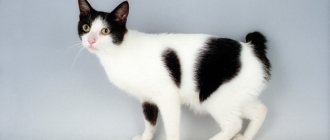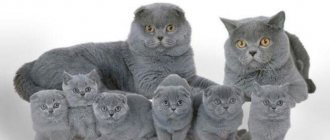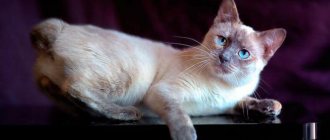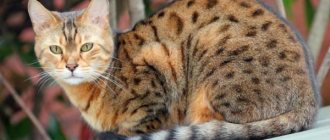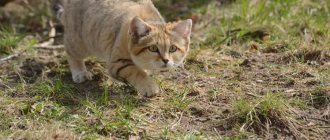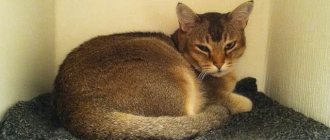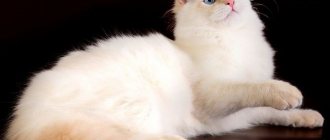Video
* We invite you to watch a video about the Chartreux . In fact, in front of you is a playlist in which you can select and watch any of 20 videos about a given cat breed by simply clicking on the button in the upper right corner of the window. In addition, the material contains quite a lot of photos. By looking at them you can find out what Chartreuse looks like.
Rate the material!
[Total votes: 1 Average: 5]
The Chartreux is a fairly rare cat breed. The simplicity of this cat is combined with elegance, and against the monochromatic background of a silky and beautiful coat, the cat’s amber eyes stand out brightly, attracting and bewitching. Let's learn more about this amazing breed, from the origins of its origins to the peculiarities of caring for these cats, having examined all the most important nuances of their life.
Content Features
Chartreux cats require special conditions of maintenance and when purchasing such a pet, you should select in advance everything that it will need.
A Chartreux cat definitely needs a spacious bed that is suitable in size for both a kitten and an adult cat. In addition, it is necessary to select and change the tray according to the age and size of the cat.
It is better to take a high-quality filler; for an accurate hit, ask what kind the breeder uses. For food and water dishes, you need to choose metal or ceramic bowls, and the bottom should be weighted.
The carrier for chartreuse should be quite spacious; for the winter period it is better to supplement it with an insulating cover.
As with any breed that has an undercoat, cats require a grooming kit: slicker brush, brush, comb, nail clipper.
Note!
Singapore cat: character, photo, price, breed description, reviews, how to buy, how to choose, maintenance, care and owner reviews
Scottish Straight: cat photo, kitten prices, breed description, character, reviews, maintenance and care, nutrition + interesting facts
Chausie - overview of the breed, character and breeding characteristics. Price for a kitten and tips for choosing a purebred cat (115 photos)
Toys are only required for chartreuse kittens, as adult cats are very lazy, but for children, choose mice and all sorts of glitter.
A scratching post of any model is a must - a simple post or cover for the arm of a sofa, or a full-fledged complex will do.
History of the origin of Chartreuse
This cat breed is considered quite ancient. Experts believe that the ancestors of modern Chartreuse were cats that inhabited the Middle East: Mesopotamia, Syria, Palestine. During the Middle Ages, they were brought by the crusaders to Europe, to France.
This is how the cats ended up in the Grande Chartreuse monastery. The Catholic monks living there initially observed the charter of the Carthusian order, according to which it was necessary to observe a vow of silence. It would seem that cats also adhered to this vow, making almost no sounds and meowing in a whisper. It’s not for nothing that Chartreuse cats are also called Carthusian cats.
Interesting fact: The name “chartreuse” was forever assigned to these cats back in the 17th century. In the next century (18th), the name of these cats appeared on the pages of dictionaries and encyclopedias and was listed as “blue cat.” This happened thanks to the outstanding natural scientists Buffon and Linnaeus.
The development of the breed in full began only after the end of the First World War, at that time even the first exhibitions were held. But after World War II ended, the Chartreux suffered a terrible fate - they almost disappeared completely.
This amazing cat species was saved thanks to the Léger sisters, who crossed the Chartreux with British and Persian cats, although this lost some of their purebredness. Chartreux were brought to the United States only in the 70s of the last century; American breeders wanted to cross them with British shorthair cats, but, fortunately, they changed their minds, preserving the cat's purebred.
Americans fell in love with this cat breed, and nurseries began to open throughout the country. England has long considered itself the copyright holder of the breed, because the Chartreuse is very similar to the British shorthair cat. Still, France is considered the country of origin of Chartreuse.
The cat standard was last edited in 1999 by the International Feline Association (CFA). The standard notes that chartreuse has been known since the Middle Ages.
History of the breed
The Carthusian cat or Chartreuse was registered as a separate breed in the sixteenth century in France. The history of the origin of the breed is ambiguous, and at the moment there are three main versions, which, according to scientists, have the right to life.
Cartesian version. Grande Chartreuse is a monastic monastery that has become famous throughout the world thanks to its first-class liqueur. According to medieval stories, the monks of the Carthusian order, in addition to performing their direct duties in the service, also bred large cats on the territory of the monastery. The theory seems plausible, because to this day there is a mountain of “Grey Cats” not far from Chartres.
Spanish version. According to this theory, the Carthusian cat was named Chartreuse because of its thick coat, which resembles the Spanish Chartreuse.
According to the third version , which does not contradict both of the above, the beautiful Carthusians are descendants of Syrian short cats with an ash color. They were brought to Europe during the Crusades in the sixteenth century.
Chartreux - description of the breed
If we talk about the general description of the Chartreux, it can be noted that the cat has a fairly powerful physique. The standard marks it as primitive, i.e. it has not changed during breeding work.
The cat's body perfectly combines grace and strength, and you can add speed of reactions and agility to them. The gender differences in these cats are immediately noticeable: females are much smaller than males. The weight of males varies from 6 to 7.5 kg, females - from 4 to 5 kg. Well-developed muscles clearly appear on the stocky cat's body.
The head of the Chartreuse is very wide, in shape it resembles an inverted trapezoid. She has a high and sloping forehead, rounded and plump cheeks. The nose is straight and short in length and width. The bridge of the nose is located at the level of the cat's eyes and is of moderate severity. The entire shape of the muzzle protrudes slightly forward. The neck of the Chartreux is short, but very massive; in combination with the round, thick-cheeked face, the cat looks good-natured and seems to be smiling. The ears are of medium size, set vertically and high. The eyes are large and not endowed with a characteristic squint.
The iris can be colored in the following shades:
- Reddish yellow;
- Yellowish-brown;
- Orange-brownish;
- Amber;
- Golden;
- Bronze;
- Bright orange.
The last eye color is the most valued. The length of the cat's tail is less than the length of the entire body. At the base it is greatly thickened, towards the end it becomes narrower; experts note its mobility and special flexibility. Chartreux cannot be called long-legged; their limbs have average parameters, they are quite strong and straight, and the front legs are smaller than the hind legs.
Kitten: how and where to choose?
The breed is recognized by such felinological associations as CFA, TICA, ACFA, FIFe. They defend the purity of blood and do not recognize hybridization. However, the British GCCF did not grant champion status to the Chartreuse. Therefore, when choosing a kitten, it is recommended to cooperate with clubs that are part of FIFe. The rest can sell British cats or a cross between two breeds under the guise of a Carthusian cat. The difference between a purebred Chartreuse cat lies not only in its blue coat. The pads on the paws should also be blue without additional color splashes. The British don’t have this feature, so you can’t confuse them.
Why Chartreuse and British Shorthair cats often get confused, as well as the unique reason for the silence of the Carthusian cat can be found in the video www.youtube.com/watch?v=bCc0mLXu24I&t=10s
Carthusian cats are beautiful, loyal and low maintenance. To keep representatives of the breed in the house, it is enough to adhere to a small set of rules and create comfortable living conditions. The animal responds to this owner with affection and boundless devotion. However, it is worth remembering that a jealous creature will not tolerate a lack of attention.
Popular Chartreuse colors
The elegant and wonderful coat of the Chartreuse can be confidently called a cat’s calling card, because it is thanks to it that this breed is valued by many cat lovers. In general, Chartreuse cats are short-haired, but it is rare to find cats with medium-length hair. Cat fur is thick, fluffy, silky, and incredibly pleasant to the touch.
This cat breed is characterized by the presence of a rather densely packed undercoat, which makes the Chartreuse look elite, stately and attractive. The undercoat also has practical significance, protecting the mustache from cold and wind.
Interesting fact: Despite the fact that the fur of Carthusian cats is not long, they shed quite profusely, which should be kept in mind for those who are prone to allergic reactions.
There is no need to say too much specifically about the color of Carthusian felines, because it is quite laconic and uniform, but this is its nobility, a special chic that gives the cats incredible attractiveness.
The coloring of chartreuse is monochromatic blue; it can vary, having certain distinctive shades, ranging from light tones to dark, gray-blue, shimmering with silvery highlights in bright light. Some experts describe the coat color of these cats as a cool shade that can vary from blue-gray to lavender tones.
Other colors and shades are not provided by the standard. Also, there should not be any specks of white or dark colors on the fur, stripes should also be excluded, this will be considered a defect. The cat's nose in Chartreuse is dark graphite in color, and the color of the pads on the paws is grayish-pink.
Breed standards
The natural strength and beauty of the Chartreux is reflected in the breed standards:
- the body is stocky, powerful, strong (the term “primitive” is applied to it);
- the size of the animal is large (males can weigh up to 7 kg, kitties are a little lighter), looks heavy;
- the head is rounded, but not spherical;
- the frontal part of the muzzle is quite wide, with a slight bend at the level of the nose;
Important! The Chartreuse's nose and paw pads are only gray-blue; other shades are considered a breed defect.
- adult animals have wide cheeks;
- ears are set high, slightly tilted forward, of medium height and width;
- the neck is short, strong, muscular;
- eyes are round, not slanted, open; color copper, orange-golden, bright orange;
- the tail is mobile, of medium length, wider at the base, slightly narrowing towards the end, does not fluff, the tip of the tail is oval;
- paws are straight, strong, of medium length, muscular, but not thick;
- wool with a dense, almost waterproof undercoat, which is slightly darker than the main tone of the coat; adults may have folds on the neck and sides;
- There are semi-longhaired and shorthaired Chartreuse, the density of the coat depends on age (in mature animals it is denser);
- The coat color can range from a light shade of blue-gray to lavender.
Interesting! In small Chartreux dogs, the tabby color sometimes appears, but there is no need to worry about this: by the age of one year, the coat will acquire an even tone.
Character and habits of Chartreuse
Naturally, each cat has its own character, in which individuality is visible, but, nevertheless, some common features are inherent in this breed, let's try to analyze them. There are three particularly pronounced qualities that Chartreuse is endowed with.
This:
- Jealousy;
- Equilibrium;
- Modesty.
Let's look at each of these three points in more detail. As for jealousy, this is precisely the trait that many owners note in Chartreux dogs. Cats will never put up with the fact that another pet will live in the house, they should feel like they are one and only, so it is not at all easy for a Chartreuse to get along with another pet, this most often does not work out, although there are exceptions. Chartreux children, having spoiled themselves, are treated with love and warmth.
Although Chartreux are playful, they know when to stop everything, they are calm and taciturn. Cats have a very quiet voice, so you shouldn’t expect violent meows from them; it seems that equanimity and balance are in their blood. Chartreuxes never get into trouble and try to avoid conflict situations. They endure various changes and inconveniences (for example, a change of place of residence). These mustaches can adapt even to prolonged loneliness.
As for modesty, it suits a Cartesian cat (more precisely, it suits its face). They are very devoted to the owner (precisely one person), having chosen him, cats become constant faithful companions, but stay a little distant so as not to seem annoying once again, Chartreux never impose themselves, showing their independence and nobility. Cats are loyal to strangers, do not show aggression, and behave quite peacefully and reservedly.
Chartreux are by nature tireless hunters, their vigilance and hearing are excellent. They perceive sounds that humans cannot understand. Cats immediately go in search of the source of this sound, sneaking up unnoticed and silently, the next stage is a well-aimed throw, with the help of which the prey (and this, most often, a mouse) is firmly pinned down. Long games with a caught trophy are not typical for Chartreuse.
Chartreux are real intellectuals; scratching everything, spoiling and breaking things is not their thing. Cats are very clean. Adult chartreuses are never averse to being lazy and taking a nap for an hour or two, which is quite typical for any ordinary, mongrel cat.
Character
Carthusians have a calm temperament. They cannot definitely be called too quiet or too playful. Short periods of high activity are often followed by long periods of rest. In general, pets lead the same moderate lifestyle as monastic monks.
They always follow a set routine - they play the same games, eat the same food, are active and sleep at the same time. If necessary, the owner can influence the cat's habits - fortunately, they are easy to train.
Chartreux dogs adapt to new conditions without much difficulty: they become attached not to their habitat, but to their owner. For this reason, Carthusian cats do not tolerate other pets easily. Of course, they will be able to live in the company of a cat or dog, but they will require special affection and attention.
They definitely need to be close to the owner, rub their muzzle against him and expose their neck to be scratched. Chartreux are ready to follow their owner's heels, and if necessary, they are always happy to bring comfort in moments of sadness or during illness.
Interesting facts about Chartreuse
There are many interesting stories and facts about such amazing cats, which we will try to present, choosing the most fascinating ones. Maybe they will encourage many to get themselves such an attractive mustachioed pet.
So, the most interesting facts about Chartez cats:
- Chartreux is considered a fairly ancient breed; scientists have proven that they were first mentioned in the 16th century;
- Chartreux cats are similar to British Shorthair cats, so the breeds can easily be confused. Until 1977, these two cat varieties were considered one breed, but after they became separated, thus emphasizing the fact that these are different types of cats. The French treat Chartreuse as a national treasure;
- Even Charles de Gaulle had a mustachioed favorite Chartreuse; he greatly appreciated his refined appearance and the habits of a real aristocrat;
- Surprisingly, today the majority of purebred Chartreuse live on the American continent, and not in France;
- In addition to the cat breed, “chartreuse” is also called a famous liqueur infused with medicinal herbs. Its recipe was also developed by the monks of the Chartreuse monastery;
- The color of the Chartreuse's undercoat differs from the overall tone of the coat; it looks darker. The skin of the animal also has a bluish color;
- Under severe stress, Chartreuse cats may begin to lose their hair, so you need to take care of the cat’s nerves so that the animal does not turn into a Sphynx cat;
- They say that the Chartreux owes its silence to the monks of the same monastery, who kept a vow of silence, and the mustachioed pets also began to follow this principle, accustomed to meowing rarely and quietly;
- In France, on the territory of the Savoie department, there is a mountain named after the Chartreuse “Mountain of Gray Cats”;
- The Carthusian monks dedicated many poems to these amazing feline creatures.
Interesting Facts
Blue beauties have attracted the attention of creative people and the aristocracy for several centuries.
- Back in the 17th century, Chartreuse skins were sold and their meat was eaten.
- Thanks to the plump round cheeks of the Chartreuse, it seems that the cat is smiling.
- Cats are very silent, their voice is soft and quiet.
- Despite their non-conflict nature, jealousy has been noticed in the pets of this breed. Still, they want to be the owner’s only favorite.
- Chartreuse have an exclusively gray-blue color, without impurities, from light to dark shades, the eyes are honey-copper, and the nose and paw pads are colored gray.
- Cats lose their fur when stressed.
- French monks dedicated many poems to cats in blue fur coats.
- In the 18th century, the artist Jean-Baptiste Perronaud depicted the blue beauty in a painting.
- Charles de Gaulle had a Chartreux pet nicknamed Gris-Gris, whom he loved very much and could talk to for hours.
- Long ears and paws, as well as an elongated muzzle, are a defect and such a cat is not suitable for breeding as a Carthusian.
- Chartreux are considered mature when they are closer to five years of age, and offspring should only be bred once they reach three years of age.
- The British Cat Association considers that the Chartreux breed does not exist, and they are classified as a British Shorthair breed.
Pros and cons of Chartreuse
Like any other animal, Chartreuse has its own characteristics. Many owners do not notice any shortcomings in these cats, because they adore them immensely. Looking at Chartreuse from the outside, you can see both the pros and cons; we will try to list them. This may help those who are planning to get such a cat.
Cat's virtues:
- Possessing a calm and obedient character;
- Boundless devotion to the owner;
- Magnificent and noble appearance;
- Delicacy and unobtrusiveness, chartreuse certainly won’t bother you;
- A quiet voice that you rarely hear;
- Cleanliness;
- Presence of intelligence and intellectual development;
- They get along well with children and don’t mind tinkering with them;
- Magnificent and passionate hunters;
- Unpretentious regarding care;
- Avoid conflicts;
- Independent and adapt well to any new conditions;
- They are the owners of fairly good health.
Disadvantages of the breed:
- Rarity, and therefore overpriced;
- Subject to heavy and frequent shedding, which can cause allergic reactions;
- Very similar to the British Smooth-haired;
- They are often obese, so you need to carefully monitor your diet;
- They may show excessive autonomy and independence;
- They do not like long and excessive caresses;
- Jealous of other pets, it is preferable that there are none at all;
- They do not like to live in a specific designated place, considering the entire house to be their territory and moving freely around it;
- Aversion to water procedures, which are not easy to carry out in autumn.
Diseases
This breed is quite strong and hardy, but it also has some problems.
Many owners notice that their pet is quickly gaining weight. And obesity, as we know, leads to a lot of diseases: cardiovascular disease, diabetes, etc. Therefore, you need to monitor its weight and not overfeed the cat.
The second problem is with the joints. Usually this disease affects already adult animals. If you notice that your pet has become lethargic, often sits in one position, moves strangely, and has stopped running and jumping, contact your veterinarian immediately. Drug therapy, started on time, helps relieve pain and significantly improve the quality of life.
Another trouble is problems with teeth and gums. Due to the special structure of the skull, the Chartreuse’s teeth grow in a special way: the incisors fit too closely together, causing discomfort. In addition, they are very small, and often push each other out. Don't hesitate to remove them if your vet advises. If you do not remove plaque and tartar from your teeth in time, your cat may lose them altogether. Take your cat to the veterinarian regularly, and if necessary, do a thorough cleaning at the veterinary clinic.
Deworming and vaccinations are mandatory even if your Chartreuse’s nose doesn’t show beyond the threshold. You yourself can become a source of infection by introducing pathogens on your clothes and hands, and worm larvae settle in both water and food. Do not refuse standard preventive procedures: they are inexpensive and bring enormous benefits!
Breeding Chartreux
Chartreux become sexually mature at the age of one year or even closer to one and a half years. It has been noticed that the maturation of cats is slightly delayed compared to females. The main thing for mating is the moment of selecting a worthy partner, which is very difficult due to the great rarity of these cats.
An important factor here is not only the presence of an excellent pedigree, but also the excellent health of both mustachioed partners. It’s worth noting right away that breeding Chartreux in our country is not possible, because these cats are mainly bred in the USA and France; breeding individuals are not exported outside these countries, so kittens that are already castrated or sterilized come to Russia. You can find out below how the mating process works in the above-mentioned countries.
For mating, the cat is brought to the territory of the male so that the latter feels confident and is not afraid of anything. Experts recommend leaving the female to stay with the cat for a couple of days to ensure a guaranteed pregnancy of the cat, which lasts for two months. Usually, there are 2 - 4 kittens in a litter, very rarely there are 5 babies. Most often, Chartreuses themselves cope well with all the difficulties associated with childbirth, so it is quite possible to do without medical help, of course, if no complications are observed.
In the first weeks of life, kittens need only maternal warmth and breast milk. At this time, only the mother cat should take care of the babies’ nutrition, and owners should only take care of feeding her, providing all the necessary vitamins and minerals. Kittens become sighted between 7 and 10 days of age; their development rate can be called moderate.
Closer to the age of one month, they are already quite capable of going to the litter box. At six weeks they begin to wash themselves, communicate more vividly with each other, behaving like adult relatives, at the same time they acquire their noble and refined coloring. Three months of age is considered the best time to hand over grown babies to new owners. It should be added that the average lifespan of Chartreuse is 12 years, but there are specimens that lived up to 16.
Chartreuse cat breed: origin, history
The history of the breed of these beautiful creatures goes back to the distant 16th century, when, as legend says, cats with dense blue-gray fur and a cold copper look were brought to Europe. The animals easily got used to the environment, reproduced well and felt quite comfortable. But Europeans fell in love with cats not only for their beauty: they were bred for their warm fur, which was used for making clothes, and tasty meat.
So, probably, these animals would have disappeared completely, but, as another legend states, the Chartreuse was bred by the monks of the Carthusian Order (hence the cat’s second name), who lived in the territory of Grande Chartreuse. The animals were treated with great respect and they even named a hill in their honor – Gray Cat Mountain, which still exists. Proof of this theory is a poem by one of the monks, in which he expresses his love for and admiration for a blue-gray cat.
Interesting! In the mid-20th century, the famous French writer Sidonie-Gabrielle Colette dedicated her novel “The Cat” to the story of a Carthusian beauty with blue fur and copper eyes.
Little is known about the further existence of the Chartreux: the cats multiplied, many lived on their own on the streets, some lived in the houses of ordinary people, where they regularly caught rodents. Over time, there were fewer and fewer animals that were still eaten.
It was only at the beginning of the 20th century that breeders became interested in this breed of cat. French chartreuse at that time practically ceased to exist. Thanks to the efforts of the breeders, already in 1928 the first representatives of the Carthusian breed were presented at an exhibition, where they were very warmly received. But no one began to seriously breed and describe this cat.
In the 70s, Chartreux began to be bred in the USA, and only then did the breed receive due attention. In the early 80s, standards were described and the breed received official status in the World Cat Federation.
Currently, there are nurseries engaged in breeding Chartreux in almost all countries of the world, but there are not many of them, so the animals are still considered rare.
Caring for Chartreuse
Carthusian cats cannot be called picky; they do not require any privileged conditions, they are unpretentious in care, which is good news. Naturally, it is necessary to take care of mustachioed pets by carefully monitoring their appearance, behavior and carrying out certain hygiene procedures.
Important fact: You should definitely pay attention to the cat's fur coat; to do this, you need to comb it at least once a week, or more often, cats really like this massage. When Chartreuse sheds, this must be done constantly and with a coarser brush.
Cat teeth are also cleaned weekly using a special, coarse brush and paste for animals. Such dental procedures not only remove food particles, but also eliminate the appearance of tartar. Cat's eyes also require care; they need to be washed with tea or a special product using a soft cloth or cotton pads, the main thing is that they do not leave lint.
A couple of times per month you need to inspect your ears, wiping them from the inside with a cotton pad dipped in water. This is not to the liking of the Chartreuse, so you need to show remarkable skill and accuracy. Cats should have their nails trimmed once a month using a special nail clipper; only the very ends need to be trimmed.
With water procedures, things are not so rosy; it is not recommended to bathe Chartreuse dogs more than once or a couple of times a year, and doing so is extremely problematic. Cats hate bathing and are very impatient with it and can become aggressive. It is not easy to wash their tightly packed wool, and it takes a long time to dry.
As for arranging a specific cat’s place in the home, Chartreux does not need this; they will independently choose an area for relaxation, because restrictions and closed doors irritate them. Carthusian cats love free movement around the house, because they consider it their property. Chartreuse dogs can be trained to walk outside, they simply love it, but they prefer independent movement rather than using a leash or harness, although they also get used to these accessories.
Health and life expectancy
In general, Carthusian cats are strong and healthy, but being large, they often suffer from joint problems, especially in old age. Owners also often encounter oral diseases. A Chartreuse can get any cat disease if not properly cared for and fed. Like other cats, they need routine vaccinations and regular treatment for internal and external parasites. Average life expectancy is 13 years.
Chartreuse diet
Chartreux cats are not picky about food, cats have an excellent appetite, and this breed is prone to obesity. Therefore, experts recommend feeding cats with high-quality dry food, where all the necessary vitamin and mineral elements are balanced. Of course, only the owner decides what his pet’s food will be: natural or dry food (you cannot combine).
Food from the human table is not suitable for Chartreuse. Salt, spices, fatty and fried foods are contraindicated for them. Pork, smoked meats, and all sorts of highly salted junk foods should be excluded from the cat’s menu.
First of all, Carthusian cats should be given:
- Lean rabbit meat;
- Chicken;
- Turkey;
- Beef.
All of the above meat products are best boiled or thoroughly frozen. It is not often that cats can be treated to boiled sea fish; it is better that there are as few bones in it as possible. Instead of cereal porridges, experts recommend vegetable side dishes for these cats; Chartreuse cats are not averse to eating pumpkin, zucchini, cauliflower, and zucchini.
Fermented milk products, such as fermented baked milk or kefir, are also very useful for mustaches, but it is better to avoid milk, it is poorly digested and can cause stomach upset. Boiled chicken or quail eggs should be given once a week. They are especially useful for kittens, who are also fed cottage cheese.
There is no need to overdo it with portion sizes, do not fall for the tricks of cats looking at you with hungry eyes, remember the tendency to be overweight. Of course, you shouldn’t forget about water; access to it should be around the clock, especially if the cat eats dry food. It is better to use bottled water, but tap water will do, you just need to let it sit for about 6 to 8 hours.
Mating of a Carthusian cat
Chartreux dogs are considered fully grown when they reach two years of age. The growth of females from this time completely stops, and males can grow up to five years. When choosing a pair for mating, it is advisable to seek help from experienced breeders and nurseries.
In addition, to obtain a high-quality litter, it is recommended to use only purebred individuals. At a certain period, Carthusian cats were crossed with the British, which is why the breed became very rare. At the moment, purebred Chartreux can be found in the USA and occasionally in France.
Before mating begins, both animals must be checked by a veterinarian followed by deworming. Animals with a dislocated patella, due to the hereditary transmission of this disease, are not allowed for subsequent breeding.
Diseases and health problems
Carthusian cats have a strong immune system, so they are not susceptible to attacks from various viral diseases, but they do have some congenital problems. These include dislocations of the kneecaps, which are the most common. This can lead the cat to lameness and weakness of the hind legs; such cats are discarded from the reproduction process.
Important fact: A disease such as hip dysplasia is also characteristic of Chartreuse, it can be completely stopped or its progression can be significantly slowed down if you consult a veterinarian in time.
Felines can suffer from gingivitis, which can be dangerous to their teeth, so weekly brushing and regular checkups are essential. Every year, the veterinary clinic needs to remove tartar, if any. Don’t forget that Chartreuse cats are susceptible to obesity, so choose their diet carefully and do not overfeed, because excess weight in cats can also affect the cat’s cardiovascular system, which is very dangerous.
In general, chartreuses are very strong, quite hardy, strong not only in body, but also in spirit. It’s not for nothing that they lived in the monastery from ancient times. Of no small importance for the cat’s health is the care of the owner, which consists not only of constant monitoring of the pet, but also of timely vaccination and deworming procedures so that the mustachioed pet feels needed, happy, and most importantly, healthy.
As you know, the best talisman against all illnesses is their prevention, thanks to which you can identify the disease at an early stage, easily cure it, and in many cases, ailments and problems can be completely avoided.
Health
The lack of intensive selection and the gradual development of the breed determined the high immunity level of the Chartreuse cat.
Carthusians tend to appear:
- joint diseases;
- mouth infections, especially gingivitis;
- obesity;
- dislocations;
- hip dysplasia.
Chartreuse dogs live quite a long time; with proper care, their life expectancy is 14-16 years. To maintain your pet's health, it is necessary to follow the vaccination schedule. The most important period is from 8 weeks to 1 year, when the kitten is most susceptible to viruses and infections. Additionally, it is necessary to regularly carry out deworming, especially for animals with free access to the street. Sterilization will help to significantly extend the life of a Carthusian cat that does not participate in reproduction, which will protect the pet from many diseases of the reproductive system. The appropriate age for the procedure in females has not been established, but males should be neutered after 7 months.

